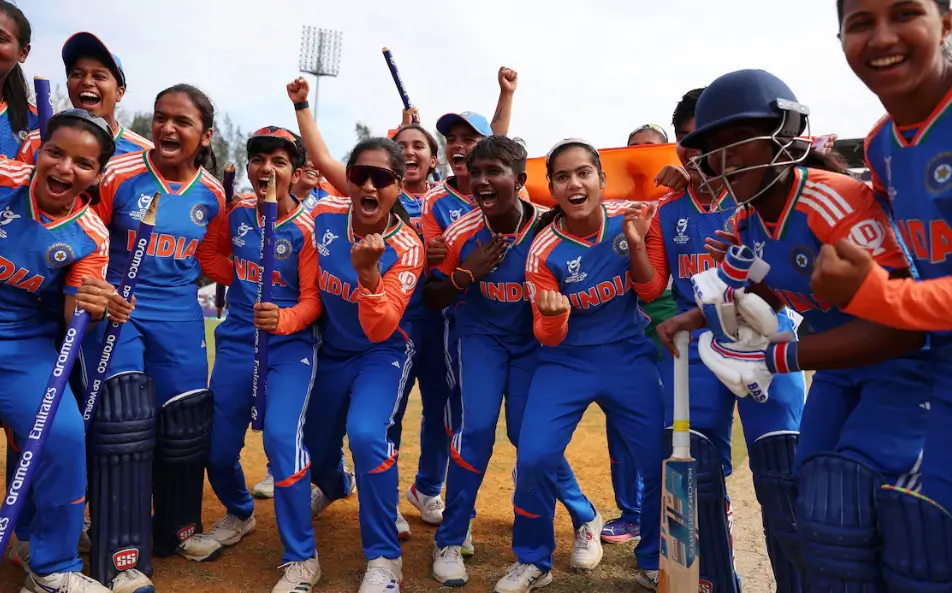CA
Sun, Dec 14, 2025 | 11:37 AM IST
| Delhi | 20°C

The United Indian



On a cool Sunday evening at DY Patil Stadium in Navi Mumbai, 45,000 fans rose to their feet, the roar echoing through the night. India’s women had finally done it - World Champions at last. In a dominant performance, they beat South Africa by 52 runs to lift the ICC Women’s World Cup for the first time. The BCCI’s ₹51 crore reward captured what the moment meant - pride, progress, and long-overdue recognition.
For years, India had come close - heartbreak in 2005, again in 2017 but this time was different. Under Harmanpreet Kaur’s calm leadership, the team showed belief and control. Smriti Mandhana’s fluent start set the tone, and the semi-final chase had already lit a spark of faith. In the final, every player stood tall. This wasn’t just victory, it was history made on home soil.
As the last wicket fell, wild celebrations erupted. Players embraced, tears were shed, and fans ticked off a long-cherished goal. For women’s sport in India, for cricket in India, this was a watershed moment.
The magnitude of the ₹51 crore bonus is worth pausing over. It signals a paradigm shift. The ICC Women’s World Cup, with its total prize pool of USD 13.88 million (approximately INR 115 crore), had already made waves by surpassing previous editions and even outstripping recent men’s events in match-win rewards and sponsorship gravity.
Yet the BCCI’s decision to award the Indian squad at this level reflects more than just a win—it reflects recognition. Recognition that this team’s feat was more than a trophy; it was a historic breakthrough. The reward is a public acknowledgment that the women’s game can deliver glory, inspiration, and value worthy of the highest stakes.
It also shines a light on leadership. Former BCCI secretary Devajit Saikia and others have long spoken of parity in sport. This payout underscores that talk turned into action.
For years, the story of India’s women in global cricket was one of near misses and unfulfilled promise. The 2005 final loss stung; in 2017, a nine-run defeat at Lord’s left a bitter after-taste. The swirl of media interest, hopes and heartbreaks followed the squad wherever they went.
In contrast, this edition of the Women’s World Cup was a study in resolve. The host nation embraced its role with poise. Crowds were larger, expectations clearer, and the entire infrastructure from broadcast to sponsorship reflected a tournament of elevated scale. India’s triumph over South Africa in the final will live in memory, but the new reward attached to it will rewrite benchmark standards.
The final itself was suffused with standout performances. Mandhana provided the skyline of ease in the top order. Kaur marshalled the middle overs, set fields astutely, and led with calm under pressure. Alongside them, the support cast bowlers, all-rounders and fielders - stepped up when the moment demanded.
India vs South Africa became more than a cricket match it became a stage for asserting parity, ambition and growth. South Africa, making their first Women’s World Cup final appearance, brought intensity and skill, but India’s team answered with composure befitting champions.
The payout is large but the narrative it underlines is larger still. It tells young girls across India: choose sport, persist, succeed and be rewarded. It tells broadcasters and sponsors: the women’s game can deliver moments, engagement and returns worthy of investment.
The ICC Women’s World Cup itself had already flagged this shift, with sponsorship valuations surging and media interest expanding rapidly. But India’s win, combined with the bonus reward, carries a deeper message: systems are changing.
Internally, in the BCCI, in state associations, in academies and clubs, the mindset is changing. The prize money is not simply cash it is investment in culture, in belief and in value.
For a generation of cricketers, financial reward was uneven. Past payouts for women’s events were modest, careers were under funded, and infrastructure lagged. This win and the accompanying prize-offers corrective momentum.
It is not purely about money. It's about what the money signifies: parity, respect, legitimacy. For the next decade, young women cricketers can look at this team and see possibility. They can expect training, recognition, and rewards aligned to achievement.
Victory and reward are milestones not finish lines. India’s triumph shines a light on the gaps that still need closing: stronger domestic leagues, deeper grassroots programs, better fitness infrastructure, and professional contracts that match the sport’s growing stature.
The surge in television ratings and sponsorship during the World Cup is a welcome start but sustaining that momentum will take intent and planning. As the players celebrate and bonuses flow in, the real test lies with the board and stakeholders to turn applause into progress. More coaches. More tournaments. Fairer pay. Smarter scouting. The cheque may be big, but the work ahead is even bigger.
India winning the World Cup at home means more than a trophy. It fits into what’s happening everywhere - women’s sport is growing fast. More people are watching, more money is coming in, and the respect is finally starting to match the effort. You can see it in football, in track, in every big event that now fills stadiums.
In India, cricket has always been about the men. This win shows that doesn’t have to be the case anymore. The crowd, the emotion and the response - it proves people care. Women’s sport is not a side story now. It’s right at the centre, and it’s only going forward from here.
For Kaur, Mandhana and their teammates, for the coaches and support staff, and for millions of fans, the moment was singular: raising the trophy, hearing the roar, seeing the tears. But in that moment lives a legacy. That legacy is now materialised in cash and in possibility.
Watching the celebrations, one could see history and hope intertwine. The scoreboard will record the victory. The cheque will validate scale. But the memory will be of the joy, of the belief, of the breakthrough.
As The United Indian looks back on that night in Navi Mumbai, the sound of celebration still feels close - the drums, the cheers and the anthem sung with pride. That night gave Indian cricket a new meaning. It was more than a victory; it was a sign of change.
The ICC Women’s World Cup win stands as a story of belief and persistence. The ₹51 crore reward from the BCCI is more than a gesture it’s recognition long overdue. Together, they show that women’s cricket in India has found its voice and its place.
The next step begins now. The challenge is to turn this moment into movement with better programmes, deeper investment, and a growing audience. Women’s cricket is no longer waiting for space. It owns it, and it’s here to stay.